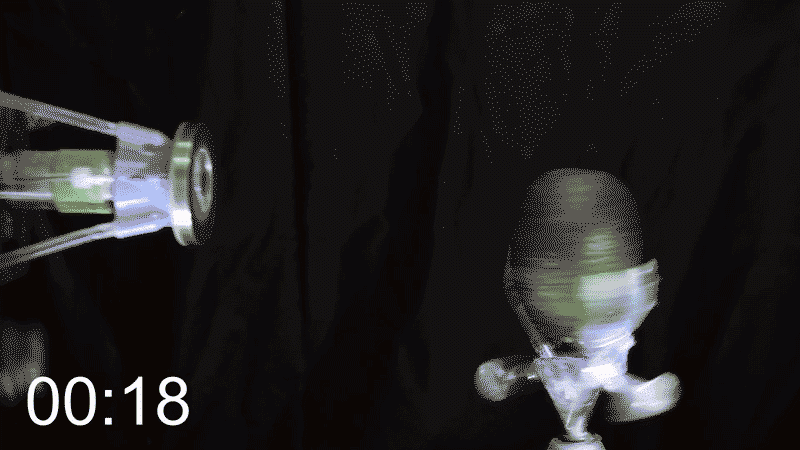Food-packaging system reduces health risks and saves food
Inspired by battlefield medicine, this antimicrobial food wrap could reduce food waste and foodborne illness
By Leah Burrows
June 27, 2023
As food costs continue to rise and a global food crisis looms on the horizon, it's staggering to think that some 30-40% of America's food supply ends up in landfills, mostly due to spoilage. At the same time, the World Health Organization estimates that foodborne illness from microbial contamination causes about 420,000 deaths per year worldwide.
What if there were a way to package fresh foods that could extend their shelf life and eliminate microbial contamination?
Now, researchers from the Harvard John A. Paulson School of Engineering and Applied Sciences (SEAS) and the Harvard T.H. Chan School of Public Health have developed a biodegradable, antimicrobial food packaging system that does both.
"One of the biggest challenges in the food supply is the distribution and viability of the food items themselves," said Kit Parker, the Tarr Family Professor of Bioengineering and Applied Physics at SEAS and senior author of the paper. "We are harnessing advances in materials science and materials processing to increase both the longevity and freshness of the food items and doing so in a sustainable model."
The research was published in Nature Food.
From the battlefield to the farm
The new food packing system has its roots in battlefield medicine. For more than a decade, Parker and his Disease Biophysics Group have been developing antimicrobial fibers for wound dressings. Their fiber manufacturing platform, known as Rotary Jet-Spinning (RJS), was designed specifically for that purpose.
RJS works likes a cotton candy machine&mdsh;a liquid polymer solution is loaded into a reservoir and pushed out through a tiny opening by centrifugal force as the device spins. As the solution leaves the reservoir, the solvent evaporates, and the polymers solidify to form fibers, with controlled diameters ranging from microscale to nanoscale.
The idea to translate the research from wound dressing to food packing was born of a collaboration with Philip Demokritou, the former co-Director of the Center for Nanotechnology and Nanotoxicology (NanoCenter) at Harvard's Chan School. The NanoCenter is a joint initiative between Harvard and Nanyang Technological University of Singapore.
"As it turned out, wound dressings have the same purpose, in some ways, as food packaging—sustaining tissues, protecting them against bacteria and fungi, and controlling moisture," said Huibin Chang, a postdoctoral fellow at SEAS and first author of the paper.
To make the fibers food-safe, the team turned to a polymer known as pullulan. Pullulan is an edible, tasteless, and naturally occurring polysaccharide commonly used in breath fresheners and mints.

The researchers dissolved the pullulan polymer in water and mixed it with range of naturally derived antimicrobial agents, including thyme oil, nisin and citric acid. The solution is then spun in an RJS system and the fibers are deposited directly on a food item. The researchers demonstrated the technique by wrapping an avocado with pullulan fibers. The result resembles a fruit wrapped in spiderweb.
The research team compared their RJS wrapping to standard aluminum foil and found a substantial reduction of contamination by microorganisms, including E.coli, L. innocua (which causes listeria), and A. fumigatus (which can cause disease in people who are immunocompromised).
"The high surface-to-volume ratio of the coating makes it much easier to kill dangerous bacteria because more bacteria are coming into contact with the antimicrobial agents than in traditional packaging," said John Zimmerman, a postdoctoral fellow at SEAS and co-author of the paper.
The team also demonstrated that their fiber wrapping increased the shelf life of avocado, a notoriously finicky fruit that can turn from ripe to rotten in a matter of hours. After 7 days on a lab bench, 90% of unwrapped avocados were rotten while only 50% of avocados wrapped in antimicrobial pullulan fibers rotted.
The wrapping is also water soluble and biodegradable, rinsing off without any residue on the avocado surface.
Making food more sustainable
This antimicrobial, biodegradable food packing system is not the Disease Biophysics Group's first foray into making our food supply system more sustainable.
Parker's group has used their RJS system to grow animal cells on edible gelatin scaffolds that mimic the texture and consistency of meat. That technology was licensed by Tender Food, a Boston-based startup that aims to combat the enormous environmental impact of the meat industry by developing a new generation of plant-based alternative meat products that have the same texture, taste, and consistency as real meat.
The lab's latest innovations in food packaging may also soon enter commercial development. Harvard Office of Technology Development has protected the intellectual property relating to this project and is now exploring commercialization opportunities with Parker's lab.
"One of my research group's the long-range goals is reducing the environmental footprint of food," said Parker. "We've done that by building more sustainable food to now packaging the food in a sustainable way that can reduce food waste."
This research was co-authored by Jie Xu, Luke A. Macqueen, Zeynep Aytac, Michael M. Peters, Tao Xu and Philip Demokritou.
It was supported by the Nanyang Technological University—Harvard T.H. Chan School of Public Health Initiative for Sustainable Nanotechnology, under project number NTUHSPH 18003; the Harvard Center for Nanoscale Systems (CNS), a member of the National Nanotechnology Coordinated Infrastructure Network (NNCI), which is supported by the National Science Foundation under NSF award number 1541959; and Harvard Materials Research Science and Engineering Center, under grant numbers DMR-1420570 and DMR-2011754.
